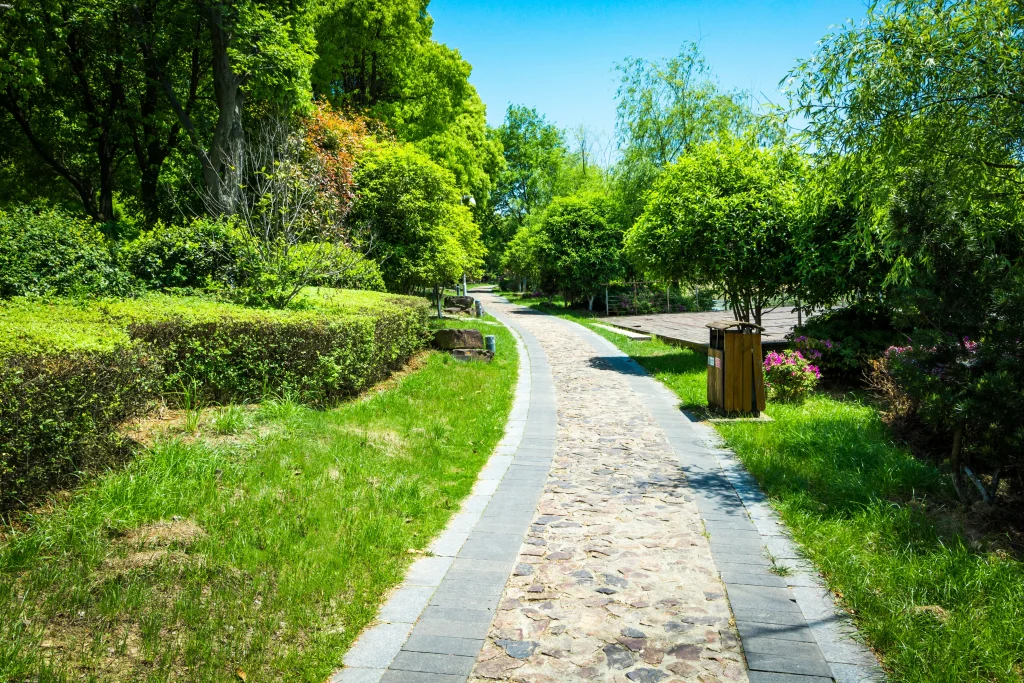Mulch is one of the simplest and most effective tools for healthy gardens, especially in Denver, where water evaporates quickly and temperature swings are extreme.
Denver sits at 5,280 feet elevation with only 15 inches of average annual rainfall – making it technically a semi-arid climate. Without proper soil protection, gardens face rapid moisture loss, temperature extremes and intense sun exposure stronger than at sea level. Mulch addresses all these challenges while reducing your maintenance workload.
In this complete guide, you’ll learn:
- What mulch is and how it works
- Different types of mulch (organic & inorganic)
- How mulch is made
- Step-by-step instructions for applying it effectively
What is mulch?
Mulch is any material – organic or inorganic – spread over the soil surface to protect, enrich, and stabilize the ground. It mimics nature’s forest floor, where leaves and organic matter naturally decompose to improve soil health.
The primary function centers on soil protection. A mulch layer shields the ground from direct sun exposure, reducing water evaporation. It also moderates soil temperature, keeping roots cooler in summer and warmer in winter.
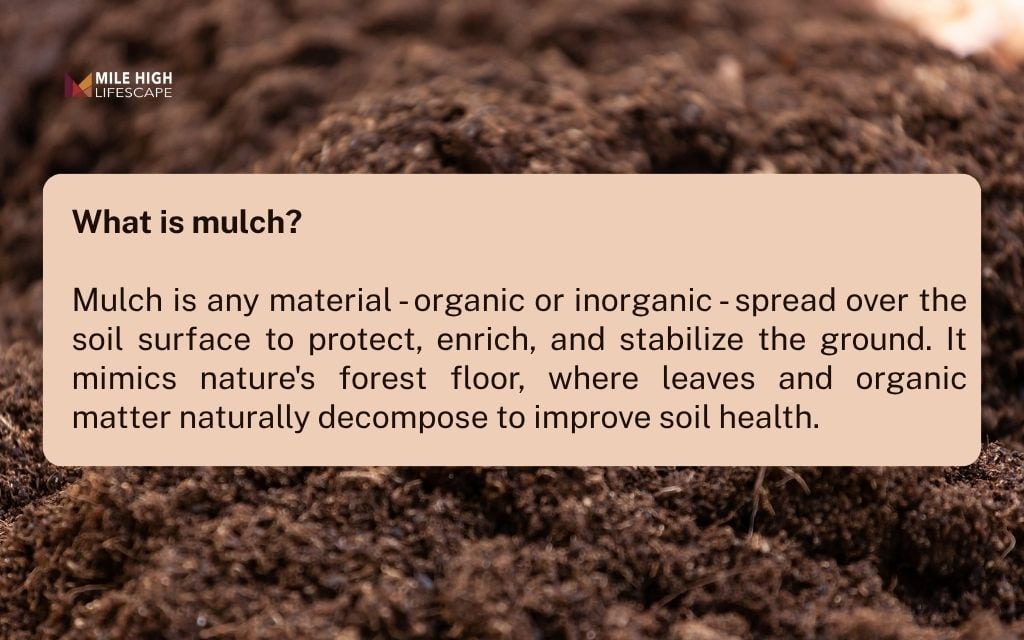
What’s in mulch?
The composition varies based on type and intended use. Understanding these components helps you select the right product for your needs.
- Organic materials include wood chips, bark, straw, compost, pine needles, leaves, and grass clippings. These break down over time, contributing organic matter to soil. Wood-based options last longer than softer materials like straw or grass.
- Inorganic materials encompass gravel, stone, recycled rubber, landscape fabric, and synthetic blends. These products resist decomposition, making them suitable for permanent installations or areas where you don’t want nutrient addition to soil.
Specialty blends combine materials to optimize performance. Commercial products often mix wood fiber with compost to enhance moisture retention while providing some nutritional value.
Choose products free of dyes or contaminants. Colored mulches can contain chemicals that harm native soils and insects. Natural options protect the ecosystem while serving their intended function.
Organic mulch
| Type | Best Use | Benefits |
| Wood chips & bark | Trees, shrubs, borders | Retains moisture, lasts multiple seasons |
| Compost mulch | Vegetable & flower beds | Improves soil structure and fertility |
| Straw or hay | Vegetable gardens | Keeps produce off soil, adds carbon |
| Pine needles | Around evergreens | Slightly acidifies soil |
| Leaves or grass clippings | Quick cover for beds | Free resource, decomposes rapidly |
Wood chips & bark
Wood chips and bark represent the most common choices for Denver landscapes. These materials decompose slowly, lasting 2-3 years before needing replacement. Cedar and pine varieties contain natural oils that repel insects and resist decomposition, making them ideal for long-term applications around trees and shrubs.
Compost mulch
Compost mulch functions differently than other organic options. While traditional mulches protect soil, compost actively feeds it. This material works best in vegetable and flower beds. The fine texture allows it to integrate into topsoil gradually, improving structure and fertility.
Straw or hay
Straw serves vegetable gardens well. It keeps fruits and vegetables clean by creating a barrier between produce and soil. The material also reflects light upward, potentially increasing photosynthesis for low-growing plants. Select weed-free straw to avoid introducing unwanted species to your garden.
Pine needles
These needles acidify soil slightly as they break down, benefiting plants that prefer lower pH. Blueberries, azaleas, and other acid-loving species thrive with pine needle mulch. The needles also interlock, resisting wind displacement – a significant advantage in exposed locations.
Leaves or grass clippings
Shred leaves before application to prevent matting, which can block water penetration. Grass clippings work best when applied in thin layers and allowed to dry between applications. These materials decompose quickly, requiring more frequent renewal than wood-based products.
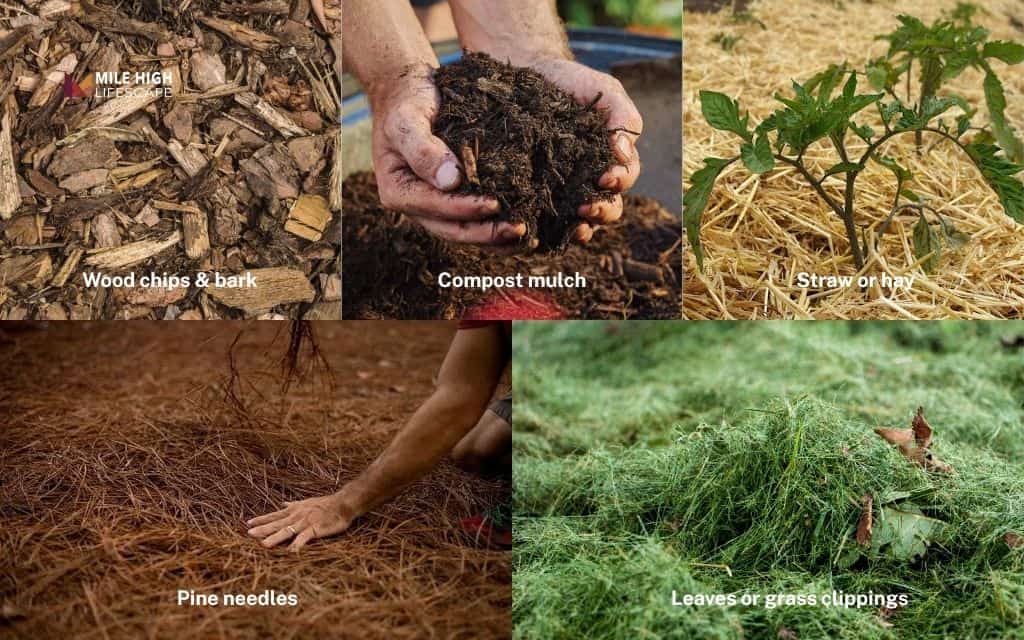
Inorganic mulch
| Type | Best Use | Benefits |
| Rock or gravel | Xeriscape, pathways | Lasts indefinitely, fire-resistant |
| Rubber mulch | Playgrounds, trees | Cushioned surface, weed-suppressing |
| Landscape fabric | Under gravel or bark | Prevents weed emergence |
| Glass or synthetic mulch | Modern design beds | Visually striking, reusable |
Rock or gravel
Rock and gravel suit xeriscape gardens. These materials last indefinitely, eliminating replacement costs and maintenance. They also resist fire, an important consideration in Colorado’s wildfire-prone regions. Choose lighter colors to reduce heat absorption.
Rubber mulch
Rubber mulch serves playgrounds and high-traffic areas. The cushioned surface absorbs impact, reducing injury risk for children. Unlike organic mulches, rubber doesn’t attract insects or decompose, maintaining consistent depth and appearance. Some gardeners also use it around trees, though organic options provide more soil benefits.
Landscape fabric
Landscape fabric controls weeds beneath other mulch types. This permeable barrier blocks light while allowing water and air to reach soil. Select UV-stable products designed for outdoor use because cheaper fabrics degrade quickly under intense sun. Install fabric before adding top layers of bark or rock.
Glass or synthetic mulch
Glass and synthetic mulches offer decorative options for contemporary landscapes. Colored glass reflects light and adds visual interest. These materials work best in small, highly visible areas where aesthetics trump function. They don’t improve soil or provide the practical benefits of traditional mulches.
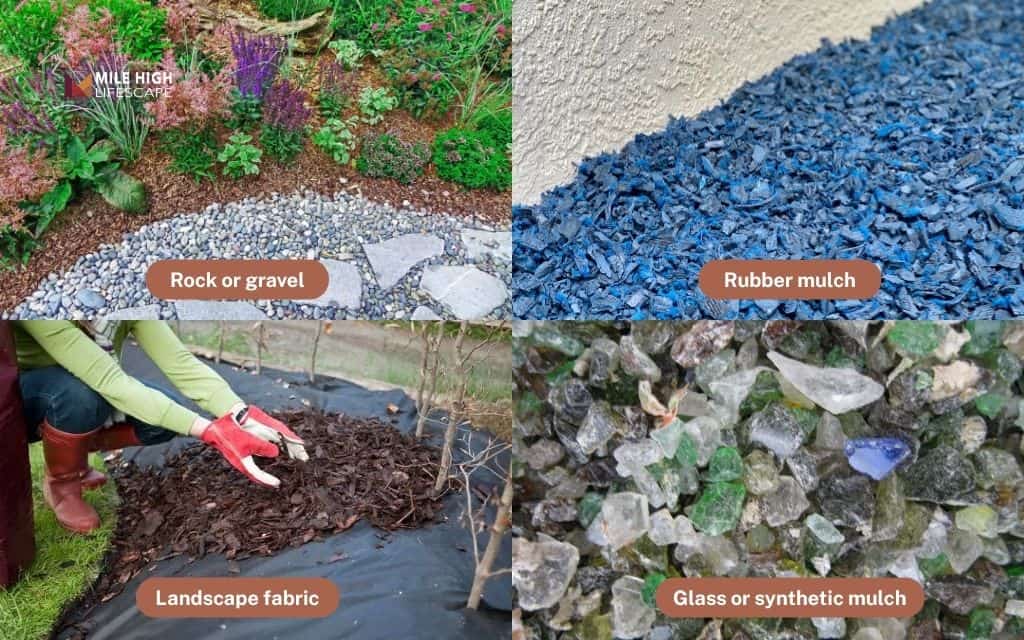
How is mulch made?
The organic mulch process
- Raw material collection: Tree trimmings, bark, leaves, or agricultural byproducts are gathered.
- Shredding or grinding: Materials are chopped into smaller, uniform pieces using industrial chippers or grinders. Smaller pieces break down faster.
- Composting or aging: Mulch is aged for 3 – 6 months to kill pathogens and stabilize nutrients. During this process, internal temperatures can reach 130-160°F, eliminating weed seeds and harmful bacteria.
- Screening: The final product is sifted to remove large debris and create consistent texture. Multiple screen sizes produce different mulch grades (fine, medium, coarse).
The inorganic mulch process
Inorganic products follow simpler production paths.
- Crushed stone and gravel are washed to remove dust and dirt, then screened to consistent sizes. The clean product goes directly to packaging or bulk storage.
- Rubber mulch comes from recycled tires. Processing removes steel belting and fabric components, leaving pure rubber. The material is ground to appropriate size, then cleaned. Some manufacturers add UV protection to prevent fading under sun exposure.
Key benefits of mulching for Denver gardens
Conserves moisture
Mulch reduces evaporation by 30 – 50%, cutting water use and irrigation costs significantly. A proper mulch layer can cut outdoor water use by thousands of gallons annually.
Summer droughts and water restrictions occur regularly. Mulched gardens maintain moisture through dry periods better than bare soil. Plants experience less stress, requiring less supplemental watering and recovering faster from heat.
Regulates soil temperature
Root zones need stable temperatures. Mulch insulates soil, keeping it cooler in summer and warmer in winter. This moderation matters where freeze-thaw cycles occur frequently from fall through spring.
Temperature fluctuations stress plants and can damage root systems. A consistent mulch layer buffers these changes, allowing roots to function normally year-round.
Suppresses weeds
Weeds compete for water, nutrients, and light. Mulch blocks sunlight from reaching weed seeds, preventing germination. The barrier also makes hand-pulling easier when weeds do emerge – roots come out cleanly from soft mulch rather than compacted soil.
Reduced weed populations mean less time spent on maintenance and fewer opportunities for weeds to go to seed. This prevention pays dividends season after season, as fewer seeds enter your soil bank.
Improves soil health
Organic mulch breaks down gradually, releasing nutrients and adding organic matter to soil. This decomposition creates humus, the stable organic component that gives soil structure and fertility. Improved soil structure enhances water retention and root penetration.
Microbial life thrives under mulch. The stable moisture and temperature conditions support beneficial bacteria and fungi that form symbiotic relationships with plant roots. These organisms help plants access nutrients and resist disease.
Prevents erosion
Denver’s spring weather brings intense thunderstorms and snowmelt. Bare soil washes away during these events, carrying nutrients and undermining plants. Mulch absorbs rainfall impact and holds soil in place.
Wind also erodes exposed soil. Denver’s location east of the mountains exposes Front Range communities to strong downslope winds. A mulch layer anchors the surface, preventing wind from stripping topsoil.
How to apply mulch correctly
Step 1: Prepare the area
Remove existing weeds and debris from the planting area. Pull weeds by hand or use appropriate tools, ensuring you extract roots. Rake away fallen leaves, twigs, and other organic debris.
Level the soil surface to prevent water from pooling. Break up any crusty surface layer to improve water penetration. Water the area thoroughly before applying mulch. This ensures soil moisture before you add the protective layer.
Step 2: Apply the mulch layer
Spread mulch 2 – 4 inches deep around plants. Use thinner layers for annuals and perennials, which have shallow roots near the surface. Apply thicker layers around trees and shrubs, which benefit from more extensive protection.
Leave a 2 – 3 inch gap around plant stems and tree trunks. Direct contact with mulch can trap moisture against bark, promoting rot and disease. This gap allows air circulation.
Extend mulch to the drip line of trees and shrubs. This outer edge, where branches end, marks the extent of the root zone. Covering this area protects the entire root system.
Step 3: Water and settle
Lightly water after spreading to help mulch settle into place. This moisture also prevents lightweight materials from blowing away before they compact naturally. The water activates decomposition in organic mulches, beginning the soil improvement process.
Step 4: Maintain and refresh annually
Replenish mulch once a year, typically in spring. Winter weather and natural decomposition reduce depth over time. Add fresh material to maintain the recommended two to four inch layer.
Rake the existing mulch before adding new material. This breaks up any matted areas and allows you to assess what remains. In many cases, you can simply top-dress rather than removing and replacing.
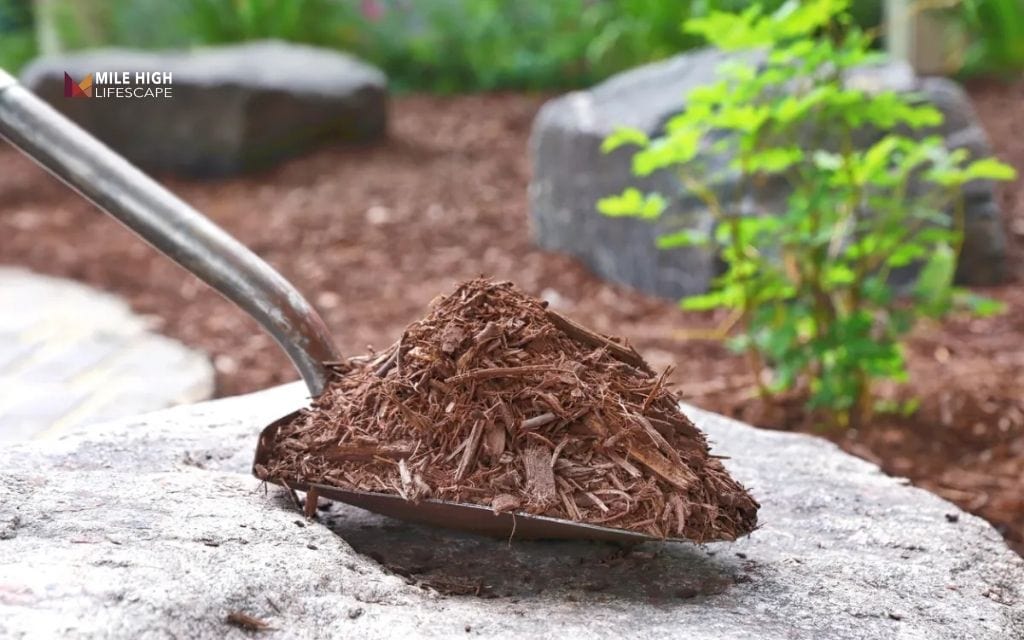
Conclusion
Mulch provides one of the most effective ways to create thriving gardens in Denver’s demanding climate. From conserving moisture and protecting roots to improving soil fertility, the right mulch transforms your landscape into a healthy, water-wise space.
The key lies in understanding your soil, plants, and environment. Natural bark and compost feed soil while protecting it. Decorative rock suits xeriscapes and permanent installations. Each option serves specific purposes within the larger landscape.
Start small, mulch smart, and let nature work for you. Your garden will reward you with reduced maintenance, lower water bills, and healthier plants.
_____________
Need expert mulching services? Mile High Lifescape provides professional mulch installation throughout the Denver Metro area. Our team understands local soil conditions and can recommend the best options for your specific property.
Contact us at (303) 877-9091 for a free consultation.
Frequently asked questions (FAQs)
What type of mulch lasts the longest?
Inorganic mulch like rock or rubber can last 5 – 10 years with minimal maintenance. Stone lasts indefinitely unless you choose to remove it. Organic mulches typically need replacement every one to two years as they decompose.
How often should I replace mulch in Denver?
Replace organic mulch every 1 – 2 years. The dry climate and intense sun accelerate decomposition compared to more humid regions. Inorganic mulch requires renewal every 5 years or as needed for aesthetic purposes.
Can I mix different types of mulch?
You can layer different types for combined benefits. Many gardeners apply compost directly to soil for nutrition, then add bark or rock on top for appearance and weed suppression. This approach combines functional and decorative properties.
Is mulch safe for pets?
Most natural mulches pose no risk to pets. Avoid cocoa mulch, which contains theobromine, the same compound that makes chocolate toxic to dogs. Cedar, pine bark, and stone mulches are safe options for households with pets.
What’s the best time to mulch in Denver?
Apply mulch in late spring or early summer, after soil warms but before peak heat arrives. This timing allows soil to receive spring warming while providing protection during the demanding summer months. Fall application also works, protecting soil through winter while preparing beds for spring growth.
